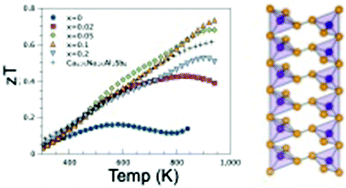Thermoelectric properties of Zn-doped Ca5In2Sb6
Abstract
The Zintl compound Ca5Al2Sb6 is a promising thermoelectric material with exceptionally low lattice thermal conductivity resulting from its complex crystal structure. In common with the Al analogue, Ca5In2Sb6 is naturally an intrinsic semiconductor with a low p-type carrier concentration. Here, we improve the thermoelectric properties of Ca5In2Sb6 by substituting Zn2+ on the In3+ site. With increasing Zn substitution, the Ca5In2−xZnxSb6 system exhibits increased p-type carrier concentration and a resulting transition from non-degenerate to degenerate semiconducting behavior. A single parabolic band model was used to estimate an effective mass in Ca5In2Sb6 of m* = 2me, which is comparable to the Al analogue, in good agreement with density functional calculations. Doping with Zn enables rational optimization of the electronic transport properties and increased zT in accordance with a single parabolic band model. The maximum figure of merit obtained in optimally Zn-doped Ca5In2Sb6 is 0.7 at 1000 K. While undoped Ca5In2Sb6 has both improved electronic mobility and reduced lattice thermal conductivity relative to Ca5Al2Sb6, these benefits did not dramatically improve the Zn-doped samples, leading to only a modest increase in zT relative to optimally doped Ca5Al2Sb6.


 Please wait while we load your content...
Please wait while we load your content...